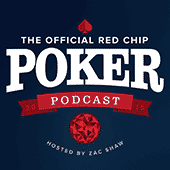When it comes to poker tells, there are few on this Earth more knowledgable than Blake Eastman. It’s not just that he’s dedicated his life to the serious scientific study of nonverbal and verbal tells in poker. It’s not just that he’s an accomplished player in his own right. Eastman, with his Beyond Tells training site, has armed hundreds of poker players with a serious edge over their competition when it comes to reading live tells. He’s on the podcast this week to announce the exciting evolution of his Beyond Tells research: the largest study ever on the behavior of poker players.

Eastman began by describing how Beyond Tells 2.0 came to fruition:
“For the past four years, we have been conducting the largest study ever on the behavior of poker players… no one’s really approached it with a data-driven scientific approach (like us). We put a bunch of players in a room, we assembled thousands of hours of video, and then we tag and track every single thing that they do. So, for example, every single player that was in our sample, every single time they blink, every single time they smile, every single time they check their cards, we tag that.”
Eastman took this mountain of data and crunched it into some incredibly useful insights, and the first sceintifically sound understanding of how poker tells are manifested.
His background as an adjunct phsychology professor at CUNY and as owner of a behavioral research company called the Nonverbal Group makes him uniquely qualified to helm this project. He cited the ineffeciency of academia as the reason he left that world to pursue a more entrepreneurial path, yet he draws on his academic background heavily in creating his products and offering his services.
When he first began Beyond Tells, he reailzed that a lot of people were not ready for the advanced information on tells that he had to offer, so he began School of Cards to teach the strategy elements that players need to understand tells in their proper context.
More than 60 people touched the data that comprises Beyond Tells 2.0, including Ph.Ds and doctors. The only way to pull off this largest-ever study of the behavior behind the game of poker was to build an entrepreneurial foundation beneath an academic base, and the results have proven worth the investment of time and money in their derivation.
“Human behavior is one of the most complex things ever,” Eastman explained, poking holes is silly arguments he sees about whether certain tells mean certain things. To understand a player’s tell, you have to understand how they think about poker. And since that is different for everyone, establishing what a tell means without the context of who exhibited it is fairly worthless.
Eastman often sees a big disconnect between well-studied players’ thought processes away from the table, and at the table. He says strategic thinking often goes out the window when the brain is under a high cognitive load, or buzzing on a high-energy emotion.
He cited one specific tell that was consistent across a the whole sample:
“Every single player that ever put a chip on their cards has had some sort of tell. Every single one. So, if you’re listening to this and you take your chip and it put it on your cards as a chip protector, it’s almost always can be reverse-engineered to figure out what your range is.”
He explains that most players think this action is a way to standardize their behavior, but they’re actually doing the opposite and creating a movement through which information can be expressed. In particular, he noticed players tend to drop their chip on their cards when playing non-premium hands preflop, whereas premium hands produced a neatly placed chip on the cards.
The moment right after a player checks their cards preflop is still the biggest leak of information, Eastman says. This has been consistent across all of his research, and he recommends waiting until it’s your turn to act before looking at your cards. The pro is that you can look at other players’ reactions to their cards and gain useful information. The con is that everyone is looking at you when you check your cards. However, if you’re confident that you’re not giving away any information, this con does not exist. If you’re still working on concealment and reading tells, he suggests trying to at least randomize when you look at your cards, and to continue to watch other players preflop.
“Think before you act,” is Eastman’s top-level, common sense advice. He says most tells come from players telegraphing their thought process in their actions and movements. The way to plug this leak is, after looking at your cards, to spend a consistent amount of time thinking, and then execute your decision in your action. In other words, don’t think as you act. Don’t make a decision by grabbing your chips and putting them in the pot. Decide first, then grab your chips.
Listen to the podcast above to get all of the value from this behind-the-scenes look at one of the most interesting poker training products to appear in quite some time, Beyond Tells 2.0.

Super interesting content. Thanks for doing this podcast. Enjoyed it very much.
Interesting. Shaw is great at what he does.